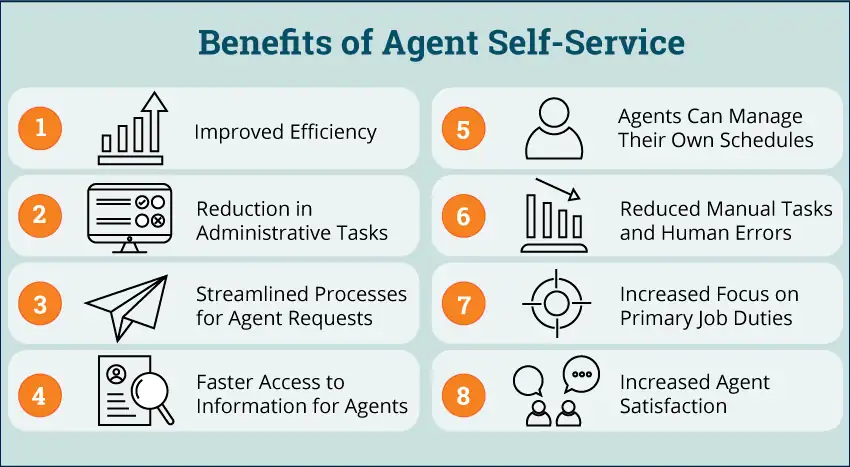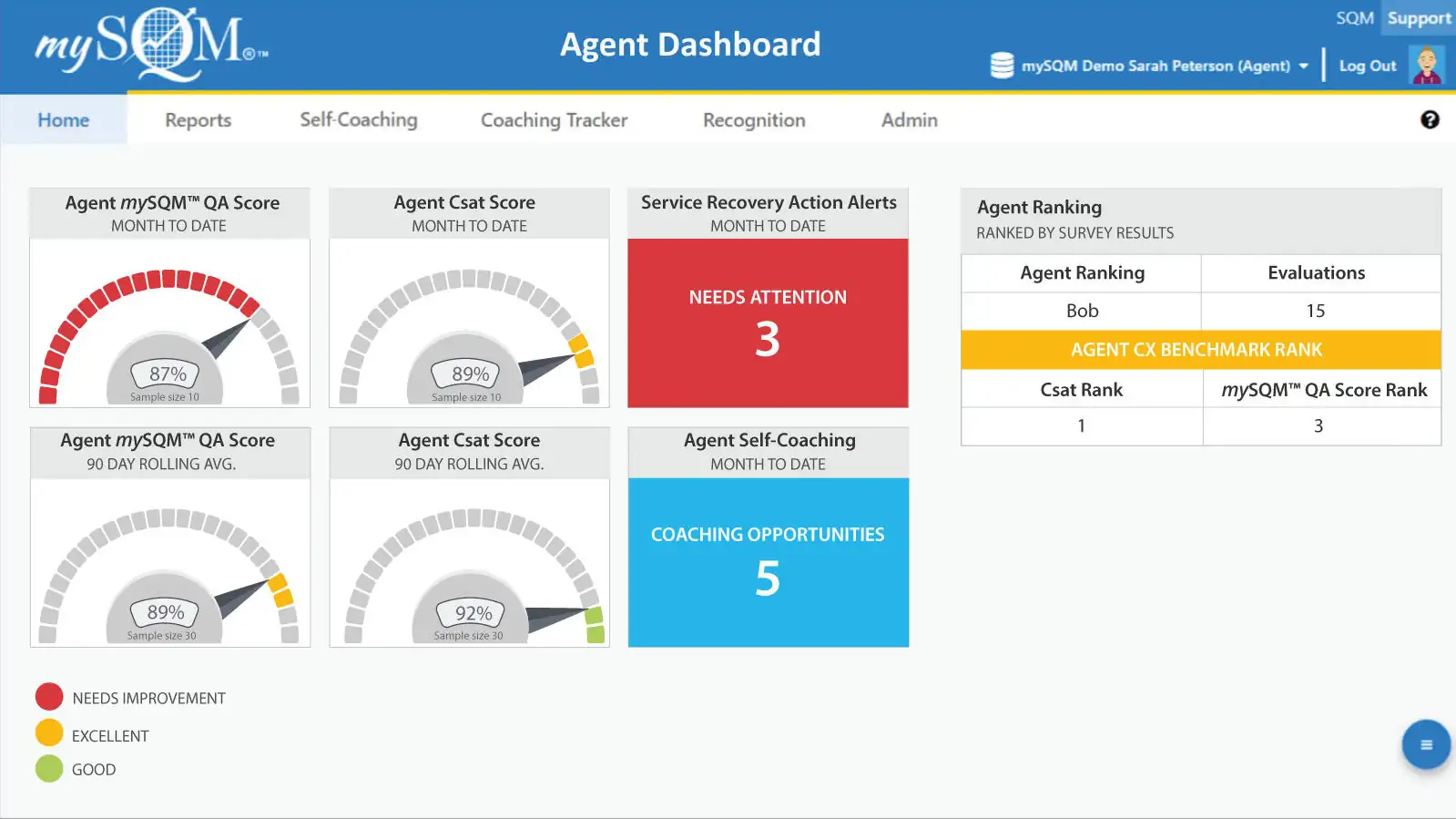Workforce management typically looks like scheduling, time and attendance tracking, workforce planning, etc. It can be cumbersome and take up time that could otherwise be put towards agent training or team development. This is where Agent Self-Service plays a helpful hand. Agent Self-Service not only empowers your workforce but also helps streamline processes and improves overall productivity and efficiency.
What Is Agent Self-Service in Call Center Workforce Management?
Agent Self-Service is an interactive tool that provides agents with direct access to their personal data and other key information. Using a secure WFM employee login, agents can view and manage their schedules, request time off, swap shifts, and even update their personal information, simultaneously reducing administrative workload in the call centers.
Agent Self-Service is more than just a fancy tool. It's a game-changer in call center workforce management. When agents can handle routine tasks independently, it empowers them and fosters a sense of ownership. Plus, it significantly reduces the time managers spend on administrative tasks and lets them focus on tasks that directly affect call center success - improving customer service, handling escalations, and driving team performance.
For example, let’s say that an agent needs to adjust their work schedule due to a personal commitment. With the self-service tool, they can easily request a shift change or time off without having to go through their supervisor. The tool streamlines the process, ensuring flexibility and autonomy for the agent, and frees up the supervisor’s time.

If the agent hadn’t had access to a self-service tool, they might have needed to contact a supervisor or manager, leading to delays and potential miscommunications. This lack of direct control over scheduling can result in decreased job satisfaction and efficiency for the agent and the supervisor.
What Are the Benefits of Agent Self-Service?

Agent Self-Service tools have greatly increased efficiency within the call center environment. By automating administrative tasks, these platforms drastically increase efficiency. Instead of manually tracking hours or updating personnel records, systems automatically perform these activities, saving valuable time. With this time reclaimed, teams can concentrate on other critical aspects of their work.
For example, without self-service tools, manual entry and tracking of work hours would be a time-consuming task for both agents and managers. However, with the implementation of an Agent Self-Service tool, agents can easily log in, enter their work hours, and access their schedules without manager intervention.
Employing an Agent Self-Service system effectively reduces the administrative burden on supervisors and management. Tasks traditionally assigned to these personnel - managing time-off requests, updating agent information, monitoring clock-ins and clock-outs - are shifted directly to the agents, freeing up supervisors and managers to focus on strategic planning and problem-solving.
For example, rather than requiring a supervisor to approve a time-off request and cover the absent agent’s shift(s), the self-service system can adjust the schedule based on other agents’ availability. This automated process reduces the risk of error while simultaneously simplifying the process.
Agent Self-Service serves to streamline many agent-related processes. Instead of submitting paperwork and waiting for approval, agents can request time off, shift changes, or update personal information all within a self-service platform. This direct access to management systems leads to quicker approvals, faster processing, and less room for error.
For example, if an agent wishes to update their home address, they can simply log into their employee portal and edit the address on their profile. This is much more streamlined than emailing their supervisor with the new address, requiring the supervisor to manually edit the agent’s address in the system.
One of the key benefits of Agent Self-Service is the real-time, instant access to information. Whether it's about agent performance, payroll, benefits, or schedules, agents can gain immediate, anytime access to their information. This eliminates the need for back-and-forth with management, leading to better use of everyone's time and quicker resolution of agent issues.
The best example of this is using a dashboard. For example, SQM's Agent Dashboard includes call resolution and Csat gauge chart widgets that provide performance score insights and action alerts widgets to identify service recovery and coaching opportunities. Also, the agent dashboard shows how they rank for Csat and call resolution; out of all the features of mySQM™ Customer Service QA Software, customers like the dashboard the best.

Request a mySQM™ Customer Service QA Demo Video
Learn about SQM's agent… CSAT prediction model, which is based on standardized metrics, AI, and regression analysis to predict customer satisfaction derived from a QA evaluation. Our CSAT prediction model provides a high statistical correlation, translating to a 95% success rate in predicting agent CSAT in most cases.
Self-service tools empower agents to manage their schedules and time off, leading to a significant improvement in organizational productivity. When agents have control over their schedules, they can better manage their work-life balance which often results in higher motivation and increased efficiency.
For example, if an agent needs to book time off the following week for an appointment, they can just request the time off through the self-service portal rather than go through their supervisor which could potentially take a day or more to confirm. This takes the strain off the supervisor, and it gives the agent more control over their schedule and their life.
When operations are automated, the prevalence of human errors decreases dramatically. Automated systems also eradicate the need for physical paperwork, eliminating the challenges related to misplaced or lost documents.
For example, rather than printing out a form for agents to sign, they can just be uploaded onto the agents’ self-service portal for them to digitally sign.
With Agent Self-Service, agents depart from worrying about administrative tasks and concentrate more on their primary job responsibilities. This shift of focus allows for more dedicated time spent on primary tasks, thereby increasing effectiveness and productivity.
For instance, without such tools, agents might spend a considerable amount of time manually updating customer records or logging interactions into the system. With Agent Self-Service, these administrative duties are automated. Agents can easily access customer information, update records, and log interactions through a user-friendly interface.
The adoption of Agent Self-Service leads to increased agent satisfaction. Providing agents with the capability to access and manage their personal information fosters a sense of autonomy and satisfaction among members of the workforce. The convenience of accessing personal documents or information on-demand anytime, anywhere, increases agents' perception of their employer, ultimately fostering a more positive work environment.
For example, agents can access and manage their personal information through a self-service portal. Instead of relying on supervisors for routine tasks such as updating contact details or tax forms, agents can independently and conveniently make these changes themselves.
Tips for Implementing Agent Self-Service in Call Center Workforce Management
Stepping into the realm of Agent Self-Service in call center workforce management requires careful planning, a solid approach, and the selection of the right self-service platform.
How to Choose the Right Self-Service Platform?
Being assertive in selecting the right platform to fit your specific needs is crucial. Not only must your chosen platform host features that aid in the delivery of your business goals, but it must also be user-friendly - ensuring your agents can navigate it without friction. Look for platforms offering elements like WFM agent login, and straightforward navigational elements.
All self-service platforms come with varying features and functionalities, but it is important to consider what applies to your call center. Make sure the platform incorporates automation features, real-time updates, easy integration with existing systems, and comprehensive reporting capabilities.
How to Overcome Challenges and Obstacles?
Implementing a self-service platform might come with its share of challenges - issues related to change management, resistance from agents, financial constraints, or even technical hurdles. However, the true edge lies in identifying these obstacles early on and confronting them head-on. Having a robust plan in place can help you counter any obstacle that tries to hinder productivity or efficiency.
For example, agents may be resistant to adapting to new technologies or workflows, fearing job displacement or unfamiliarity with the new system. To counteract this resistance, conduct thorough training sessions, communicate the benefits of the self-service platform, and involve agents in the decision-making process. Foster a culture that values continuous learning and innovation.
Implementing a self-service platform can also have associated costs, including technology investment, training expenses, and potential productivity dips during the transition. It’s important to conduct a cost-benefit analysis to showcase the long-term advantages of the self-service platform before implementation.
Another common challenge has to do with the technical side of things such as compatibility issues, data migration problems, or disruptions in existing workflows. To avoid or minimize these types of challenges, be sure to work closely with IT teams and vendors to address any compatibility issues. Plan for a phased implementation to minimize disruptions and have contingency plans in place for any unexpected technical issues.








